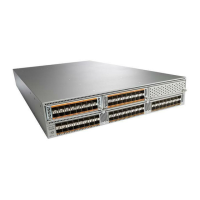On a switch with IOD enabled, all frames received by a specific ingress port and destined to a certain egress
port are always delivered in the same order in which they were received.
Use IOD only if your environment cannot support out-of-order frame delivery.
If you enable IOD, the graceful shutdown feature is not implemented.
Reordering Network Frames
When you experience a route change in the network, the new selected path might be faster or less congested
than the old route (See the following figure).
Figure 39: Route Change Delivery
In the figure above, the new path from Switch 1 to Switch 4 is faster. In this scenario, Frame 3 and Frame 4
might be delivered before Frame 1 and Frame 2.
If the in-order guarantee feature is enabled, the frames within the network are delivered as follows:
•
Frames in the network are delivered in the order in which they are transmitted.
•
Frames that cannot be delivered in order within the network latency drop period are dropped inside the
network.
Reordering SAN Port Channel Frames
When a link change occurs in a SAN port channel, the frames for the same exchange or the same flow can
switch from one path to another faster path (See the following figure).
Figure 40: Link Congestion Delivery
In the figure above, the port of the old path (red dot) is congested. In this scenario, Frame 3 and Frame 4 can
be delivered before Frame 1 and Frame 2.
Cisco Nexus 5000 Series NX-OS SAN Switching Configuration Guide, Release 5.2(1)N1(1)
192 OL-27583-01
Configuring Fibre Channel Routing Services and Protocols
In-Order Delivery

